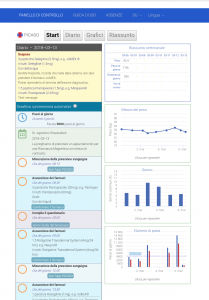The PICASO project is in its final stages with only three more months to go and we are eager to share the accomplishments of the project. We would therefore like to invite you to join us at our interactive webcast: The PICASO Innovative Solutions for Integrated Care.
Update: The webcast is now available in the archive.
This first of two webcasts will be aired live on 26th March 2019 at 10:00CET.
To follow the webcast click here.
|
In this link you can also see the agenda and speaker profiles, the slides they present and you can pose questions to the speakers by filling in the feedback form. After that date you can access and see the archived version here: https://in-jet.public-i.tv/core/portal/home.
In this post you can read more about the PICASO results that will be presented and discussed at the webcast. We hope that you will join us on the 26 March.
Agenda Tuesday 26 March 2019, 10:00-11:30CET
| Meeting Subject: |
The PICASO Innovative Solutions for Integrated Care |
| Venue: |
Webinar broadcast from Fraunhofer FIT, Sankt Augustin, Germany |
| Date: |
Tuesday 26 March 2019 @ 10:00CET |
| Time |
Webinar:
The PICASO Innovative Solutions for Integrated Care
|
| 10:00 |
Welcome to the PICASO Project
by Carlos A. Velasco, Project Coordinator, Fraunhofer FIT
Webinar presentations introduced and moderated by Jesper Thestrup, In-JeT ApS
|
| 10:05 |
PICASO Technical Overview and Architecture
by Peter Rosengren, CNet Svenska
The PICASO platform enables sharing of a patient’s complete care pathways with tools to establish health status, predict risks and adjust care. By monitoring physiological parameters at home, patients can actively participate in their own care. The result is better management of co-existing diseases and coordination of care plans across organisations.
|
| Q&A session |
| 10:20 |
The FHIR Platform as an Interoperability Basis – Clinician Dashboard Overview
by Carlos A. Velasco, Fraunhofer FIT
PICASO provides a HL7 FHIR (Fast Healthcare Interoperability Resources), enabled integration platform for sharing a patient’s complete care pathways across multi-actor care spaces. A Clinician Dashboard provides an integrated user interface to the main clinical functions and tools.
|
| Q&A session |
| 10:35 |
Web-based Technologies Employed in Integrated Data Visualisation
by Jan Hreno, Technical University of Kosice
A Data Resource Browser and a Patient Data Viewer are provided to the care professionals to enable intuitive and quick search and browsing of patient data in distributed data repositories.
|
| Q&A session |
| 10:45 |
The PICASO Risk Manager and DIVA
by Armanas Povilionis, Fondazione Universitaria Inuit Tor Vergata
The risk manager provides patient specific risk estimates at a clinician’s fingertips. Risk scores from standard risk charts as well as novel risk scores that use machine learning to fuse data from an entire patient’s history into a single integrated risk score in one single tool. A Distributed Validation Authority (DIVA) ensures that data are only shared if all policies and transaction specific privacy and security requirements are met.
|
| Q&A session |
| 11:00 |
Patient Dashboard
by Matts Ahlsen, CNet Svenska
PICASO implements a number of services to allow for patients to be able to self-manage their diseases and monitor different vital signs under the supervision of formal as well as informal carers. This includes software for connecting home monitoring devices, accessing external cloud services and a Patient Dashboard for visualising vital signs and provide a diary for activities.
|
| Q&A session |
| 11:15 |
Summary and final comments |
| 11:30 |
End of webinar |
Presentation Abstracts
The following five topics will be presented at the workshop that will be webcasted live on 26 March 2019.
PICASO technical overview and architecture
Presented by Peter Rosengreen, CNet Svenska AB
The PICASO integration platform is built on a federation of multiple external and internal cloud solutions in order to match the needs of future care provision, while still respecting the legacy structure of today’s health care systems. The platform consists of three major cloud subsystems:
- Multiple legacy care information systems, each operating as a private cloud or cloud-like internal business structure with strict access control and limited access rights, including secure storage of patient data. The PICASO care management system (for creating care plans) is located inside the secure private cloud due to the need for accessing multiple critical data repositories
- The PICASO integration platform operating as a public cloud solution and providing the central integration service platform, such as management of secure data exchange between the multi-disciplinary actors, secure data collections from patients’ homes, and secure execution of care plan services
- Multiple patient and environment monitoring systems running in the patients’ homes. Each of them exposes cloud web services and are thus regarded as the patient’s ‘private cloud’.
The FHIR platform as an interoperability basis. Clinician Dashboard overview
Presented by Dr Carlos A Velasco, Fraunhofer Institute for Applied Information Technology FIT
This presentation will describe how we use the HL7®/FHIR®© standard to leverage our platform by enabling interoperability across distributed data sources coming from different health institutions and service providers. The project has developed the Reference Data Server (RDS), which is built upon a scalable NoSQL database that supports data clustering. The Reference Data Server offers a standard REST interface (also based upon the FHIR specification), supporting the extensibility of the functionality for different target groups.
Within PICASO it is used to store standard and customised code systems and value sets, medications, and templates that support the creation of services for patient care plans. The Clinician Dashboard is part of the PICASO Integrated Care Platform, providing a tool for sharing patients’ care plans across multi-actor care spaces from different institutions and service providers. The platform dynamically adjusts the content and management of the delivered care services, to ensure that they are always adapted to the patient’s personal health status and ability.
Web based technologies employed in integrated data visualisation (Data Resource Browser, Patient Data Viewer)
Presented by Jan Hreno, The Technical University of Kosice
Several aspects of clinical data browsing were considered for combining available visualisation technologies to present information to a clinical professional. The requirement for a quick overview is met by presenting an interactive mind map-like structure with the patient in the centre and providing the latest available observation values as nodes related to the patient. Tables, charts and timelines are then used to further investigate available data in detail, including historical data if available. Different time-specific data can be also compared on one common timeline, if needed. The developed visualisation tools provide plenty of features that support clinical professionals, creating an overview of the health status of patients with comorbidities, thus explicitly recognising possible conflicts in the treatment plan
The PICASO Risk Manager and DIVA
Presented by Armanas Povilionis, Fondazione Inuit Tor Vergata
The Risk Manager provides patient-specific risk estimates at the clinician’s fingertips. A selection of risk scores from standard risk charts as well as novel risk scores that use machine learning to fuse data from the entire patient history into a single integrated risk score are deployed in one single tool. This includes the effect of co-morbidities as well as genetic, social and behavioural data. Such an integrated simulation tool allows the clinicians to explore with their patients what lifestyle changes will have the strongest impact on improving outcomes.
DIVA (DIstributed Validation Authority) ensures that data is only shared if all policies and transaction-specific privacy and security requirements are met. DIVA is combination of three components: Access Manager, Identity Manager and Policy Manager which ensures the following:
- A secure connection to the PICASO Public Cloud and secure communication between Public and Local Clouds
- That all actors are identified and authenticated while accessing PICASO services and that access to data is gained only if all necessary requirements are met
- That data transactions are valid and compliant with pre-defined consent policy rules
Patient Dashboard
Presented by Matts Ahlsen, CNet Svenska AB
Measuring and monitoring of physiological parameters at home have clinical benefits and positive effects on the quality of life for chronic patients, because patients can play a more active role in their own care. The PICASO patient solution entails an easy-to-use dashboard where patients can measure important physiological parameters and monitor their health status for increased knowledge, a better overview and more control. The main functions include:
- Care plan diary with schedules for medication intake
- List of health measurements to do
- List of clinical appointments
- Integration of multiple care plans for easy overview and adherence
- Sharing of monitored data with relevant stakeholders based on informed consent.

We hope that you will join us on 26th March 2019 at 10:00CET.
The PICASO Innovative Solutions for Integrated Care
Invitation
The PICASO project invites you to join this webinar where you will see innovative ICT solutions for care plan interoperability across care organisations, technologies for browsing for and visualising clinical data located across the care spectrum as well as risk management and patient interaction for remote monitoring.
Participants – who should attend?
This webinar is intended for Software Architects, Design Team Leaders, Project Engineers and Development Managers involved in software planning and development for integrated healthcare solutions. It is also intended for clinical users, physicians, healthcare authorities wanted to get acquainted with the newest technologies for care management.
All the listed speakers and other participants of the PICASO project as well as invited researchers from Fraunhofer FIT will be physical present in the webinar room during recording.
After each session, the speakers will take questions and discuss short topics with the audience.
Information and directions for how to watch the webinar
The webinar will be broadcasted live and from the archive via the internet and can be seen in a standard browser-based player. All common players are supported and no special plugins are needed.
The player will show the video and sound from the meeting, the name of the speaker, the slides presented and the topic discussed. Contextual information in the form of relevant documents and links are also presented.
During the live webinar streaming, the viewers will be able to pose questions to the speakers directly in the webinar player. The moderator will read the questions as they arrive.
Both live and archived versions of the webinar will be available here: https://in-jet.public-i.tv/
The live webinar will be available on 26 March at 10:00 CET. The archived version will be available from the same site until December 31, 2019. The entire webcast can be downloaded from the archive.
The physical venue will be at the Fraunhofer Institute for Applied Information Technology, Schloss Birlinghoven, 53757 Sankt Augustin, Germany.
Information on the speakers
Information of the speakers is found in the webcast when you click on the speaker name.
Organisers
The webinar is organised by the PICASO project, a research project funded under the EU H2020 Framework for Research and Innovation.
You can contact the organisers in the following way:
- Questions about the project and the content: Carlos A. Velasco – carlos.velasco@fit.fraunhofer.de
- Questions about the webinar form: Jesper Thestrup – webmaster@public-i.dk
- General information about the project: www.picaso-project.eu
Copyright and acknowledgements
All copyrights for this presentation are owned in full by the PICASO Project.
Permission is granted to print material published in this presentation for personal use only. Its use for any other purpose, and in particular its commercial use or distribution, is strictly forbidden in the absence of prior written approval. PICASO has received funding from the European Union’s Horizon 2020 Framework Programme for Research and Innovation under Grant Agreement No 689209. Possible inaccuracies of information are under the responsibility of the project. This presentation reflects solely the views of its authors. The European Commission is not liable for any use that may be made of the information contained therein.


